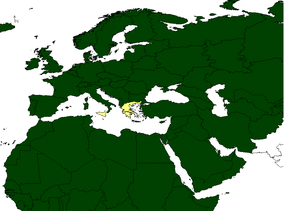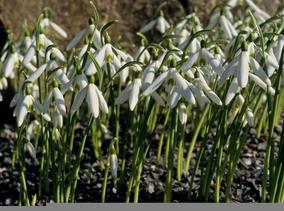You are here
About Galanthus and Sternbergia
Galanthus Wild Species
Galanthus reginae-olgae Orph.
SUMMARY
From: Davis (1999). Permission has been granted by the author.
G. reginae-olgae Orph., in Atti Congr. Intern. Botan. Firenze: 214 (1876).
G. nivalis L. subsp. reginae-olgae (Orph.) Gottl.-Tann.
BULB ± spherical to ovoid, 1.2–2.2 x 1–1.6(–2.1) cm. SHEATH 2.5–8 x 0.4–0.6 cm. Vernation applanate. LEAVES ± linear to very narrowly oblanceolate (very slightly broader in the middle to upper third), at flowering absent, or much shorter to longer than the scape, 0–20(–24) x (0.4–)0.5–1(–1.4) cm, after flowering developing to 8–18(–24) x 0.5–0.8 cm, recurving at maturity; midrib conspicuous; margins flat or subrevolute, particularly near the base of the leaf; apex acute to acute-obtuse, flat or very slightly hooded; surfaces smooth; upper and lower surfaces quite different in colour, upper surface medium to darkish green to glaucescent, with a prominent glaucescent to glaucous (grey) median stripe, matt; lower leaf surface glaucescent to glaucous, matt. SCAPE (7–)8–13(–15) cm long, green to glaucescent. PEDICEL 20–30 mm long. OUTER PERIANTH segments ± obovate to narrowly obovate, or ± elliptic, 19–25(–30) x 7–12(–18) mm, slightly unguiculate. INNER PERIANTH segments obovate to ± obtriangular, or ± oblong, 10–12 x 4–6 mm; each segment with a sinus and an apical ± V- to U-shaped green mark, often broadest at the tips (enlarged in the lobes, either side of the sinus); inner face of each segment with a faint green mark usually covering ± the entire segment. ANTHERS tapering to a long point. CAPSULE ± spherical, c.10 mm in diameter. SEEDS pale brown, c.5 mm long.
Flowers between October and March in nature; September and March in cultivation.
Notes: Galanthus reginae-olgae is a handsome snowdrop, with the prime virtue of being the first species to flower. In gardens, flowers can appear in early September, but the main display comes in early to mid-October, followed by others in November and December, by which time the earliest plants will already have started to produce their seed capsules. From late December and into early January G. reginae-olgae subsp. vernalis takes over, with some clones flowering into March.
Galanthus reginae-olgae was named by the Greek botanist and poet T.G. Orphanides in 1876, in honour of Queen Olga of Greece (1851–1926) (grandmother of the current Duke of Edinburgh). It was probably first collected in the Taigetos mountains of the Peloponnese, where it is still quite abundant.
Galanthus reginae-olgae is closely related to G. nivalis, and for many years was considered to be a subspecies of the latter. Both species have applanate vernation, narrow linear leaves, and a single green mark at the apex of each inner perianth segment, which is often the same shape. Despite the similarities between these two species there are obvious differences, including flowering time, leaf length (at flowering), and leaf colour. Galanthus reginae-olgae is predominantly autumn- to early winter-flowering, whereas G. nivalis is late winter- to early spring-flowering; these differences persist in cultivation. The leaves of G. reginae-olgae are either absent at the onset of flowering or are only about 2–3 cm long (excluding G. reginae-olgae subsp. vernalis: see below), in contrast to those of G. nivalis which are always several centimetres long at flowering time. The upper leaf surface of G. reginae-olgae has a conspicuous glaucous (greyish to grey) stripe running down the middle of the leaf. There is sometimes a greyish stripe on the leaf of G. nivalis, but it is never as obvious as that of G. reginae-olgae and is often absent. The upper leaf surface of G. reginae-olgae is usually a darker green than G. nivalis, which makes the grey median stripe more pronounced. The under surface of the leaf is usually lighter in colour (whitish grey) than G. nivalis (pale grey).
Galanthus reginae-olgae occurs in the south-western part of the former Yugoslavia, mainland Greece, Corfu, the Peloponnese, Italy, Sicily, and probably Albania. It is most common in or near woodlands, especially those of oriental plane (Platanus orientalis), pine (Pinus spp.), black pine (Pinus nigra subsp. pallasiana), and Greek fir (Abies cephalonica). It mainly grows in damp, north-facing shady places, often among rocks or in narrow gorges, and is sometimes found growing with ferns (e.g. the maidenhair fern, Adiantum capillus-veneris), near streams. It is mainly recorded growing on soils overlying sedimentary limestone, but has also been found on metamorphic rocks. The soils are usually moist, humus rich, and rather deep. Galanthus reginae-olgae occurs at a wide range of altitudes, from almost sea-level to 1,300 m, but seems to be most common above 500 m.
Despite its southerly distribution G. reginae-olgae is cold-hardy in the British Isles, but it is not as cold-tolerant as G. nivalis. If growing well, G. reginae-olgae will produce good-sized clumps in three to five years, which is when they look their best.
Galanthus reginae-olgae is divided into two subspecies: subsp. reginae-olgae and subsp. vernalis. These two subspecies are separated on flowering time, and leaf length at the onset of flowering, as summarized in the key below.
Key to subspecies of Galanthus reginae-olgae:
Leaves absent, or 1–3 cm long at the onset of flowering; autumn-flowering (October to December) ................................................................................................................................................ Subsp. reginae-olgae
Leaves present, 3–7 cm long (or more) at the onset of flowering; winter- to springflowering (December to March) ................................................................................................................................................ Subsp. vernalis






